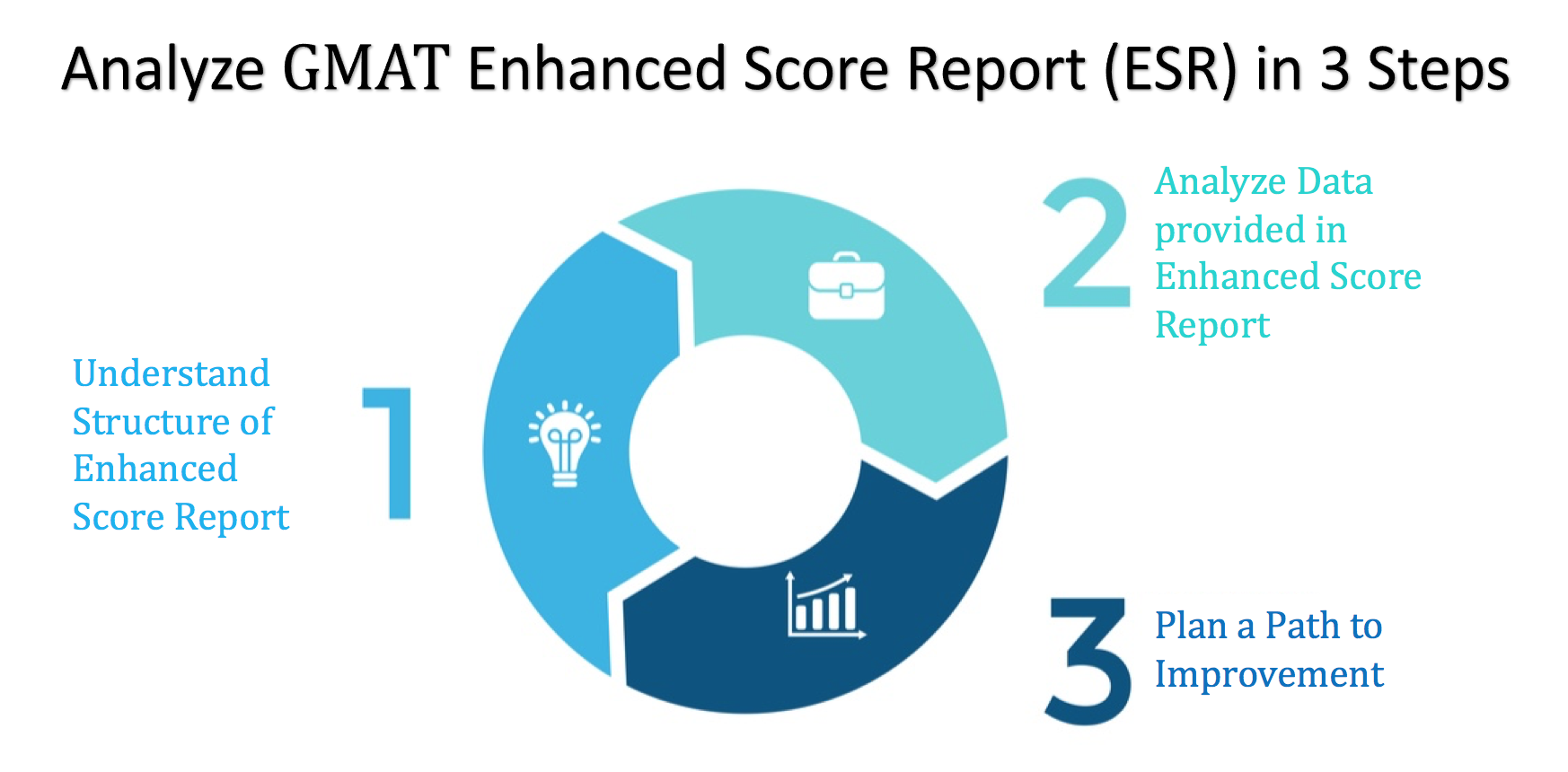The GMAT Enhanced Score Report (ESR) is an important tool to assess your performance and understand your strengths and weaknesses. The primary purpose of an Enhanced Score Report is to help you improve your GMAT score when you retake the test. To do that you should have a sound understanding of the various elements of a GMAT ESR. You should not only know what the various elements mean but also know how to interpret them and leverage them to improve your GMAT score. In this article, we have explained the process of GMAT ESR analysis in detail. But, before moving forward take a look at this video to know more about the GMAT:
Here are the 3 key steps you should follow to analyze the GMAT Enhanced Score Report (ESR):
- Step 1 – Understand the GMAT Enhanced Score Report Structure
- Step 2 – Analyze Data in GMAT Enhanced Score Report
- Step 3 – Plan a Path to improvement
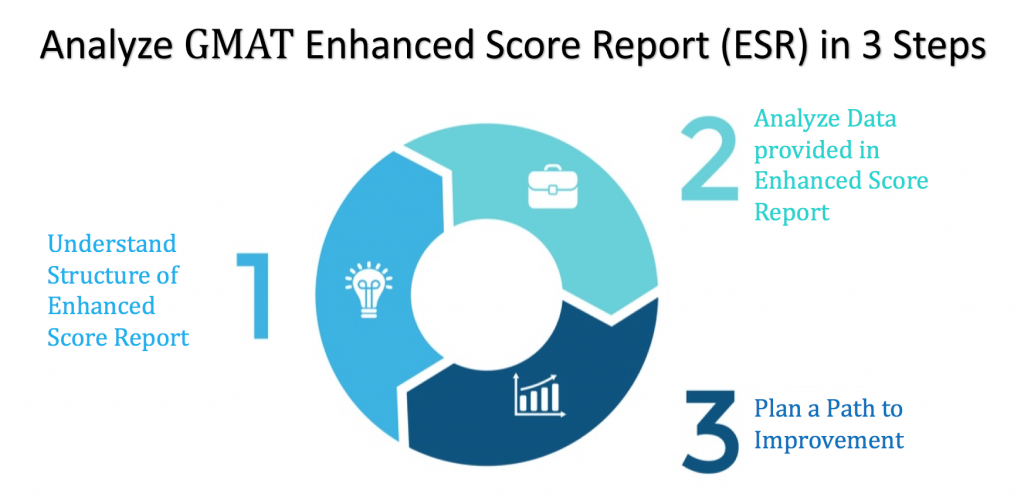
These 3 steps can be understood with the help of the following information-
- Understand the structure of the GMAT Enhanced Score Report
- Enhanced Score Report (ESR) Analysis – the e-GMAT way
- Analyze your sectional and sub-sectional abilities
- Analyze your GMAT Exam progression
- Path to improvement
- Takeaways
1. Understand the structure of the GMAT Enhanced Score Report
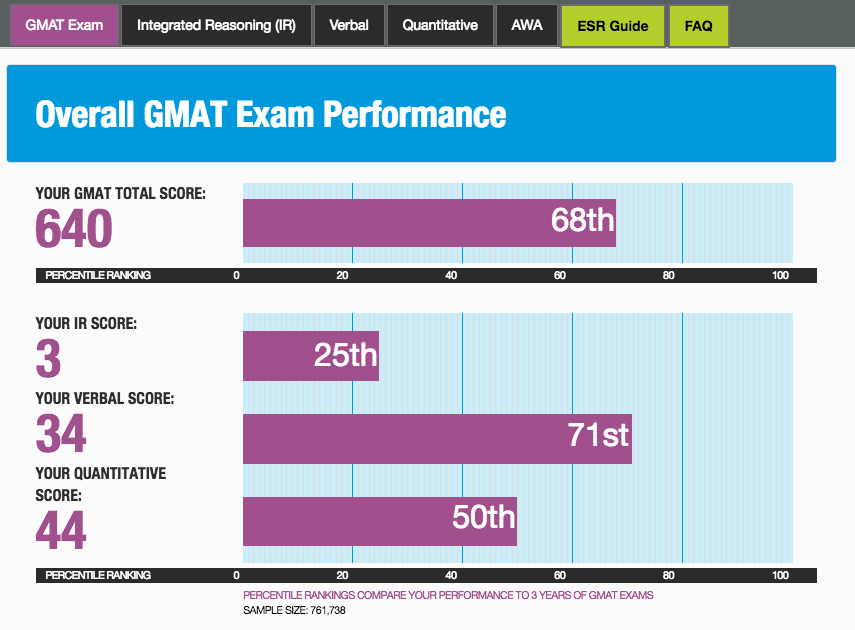
The GMAT ESR contains the following sections
- GMAT Exam
- Integrated Reasoning
- Verbal
- Quantitative
- AWA
GMAT Exam – This section provides overall GMAT exam performance. It shows the overall GMAT score, IR score, Verbal score, and Quant score with relative percentiles. Also, it provides your mean response time per question in each section.
IR section
This section shows the overall IR score, percentage of questions answered correctly and the time you took to answer an IR question correctly and incorrectly.
Verbal and Quant Sections
These are the most important sections. The total GMAT score is calculated using the scores on these two sections only.

1.1. Three categories of data in the GMAT Enhanced Score Report
In these sections, the ESR highlights your overall score and analyses your performance based on 3 categories.
- Performance by sub-section
- Performance by fundamental skills
- Performance progression
The analysis of an ESR is based on analyzing these 3 categories and therefore we’ll discuss these categories in detail a little later.
If you need help with ESR analysis, please write to us at acethegmat@e-gmat.com and we’ll help you out. If you wish to prepare well for your GMAT, then learn from the best. We are the most reviewed GMAT prep company on gmatclub with more than 1900 reviews. Why don’t you take a free trial and judge for yourself?
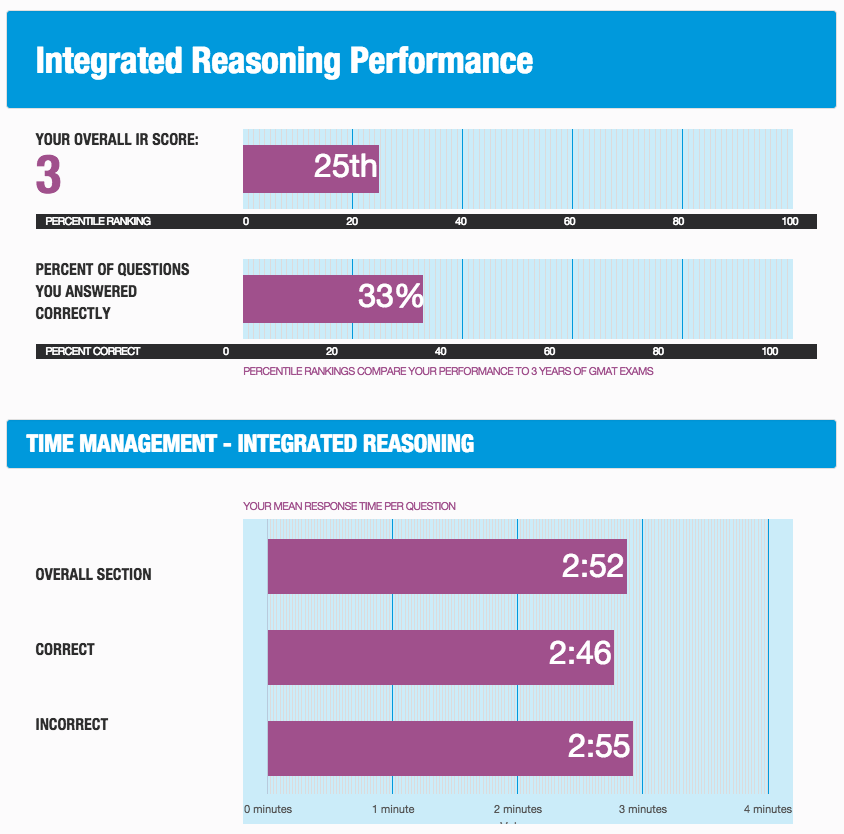
Do you know GMAC has released a new ESR in 2018? Learn more about its new features
2. ESR analysis – The e-GMAT way
The e-GMAT method of analyzing ESR has helped countless students aiming to ace the GMAT in their retake.
- Nishant improved from 570 to 740 on the GMAT by leveraging GMAT Online course. Learn how he mastered our“proprietary application processes” and used “data analytics in Scholaranium” to succeed. Click here to read his retake strategy. Watch his inspiring video interview.
So, let’s understand this method. ESR Analysis requires answers to 3 groups of questions-
- Your ability in each section and sub-section
- Progression in the exam
- The path to the target score
3. Analyze your sectional and sub-sectional abilities |GMAT ESR Analysis
Let’s take a look at the Verbal section to assess the abilities. Take a look at the sub-sectional abilities of your verbal section.
Now make note of your sub-sectional percentiles. If any of the sub-sectional percentiles is less than 50 percentile then check whether it is a true representation of your ability or not.
3.1. Why would the ability score not be a true representation?
A true representation of your ability means that a score must convey your true skill level. In the event that you don’t spend enough time on the questions in a particular section, your score may not represent your true skill level.
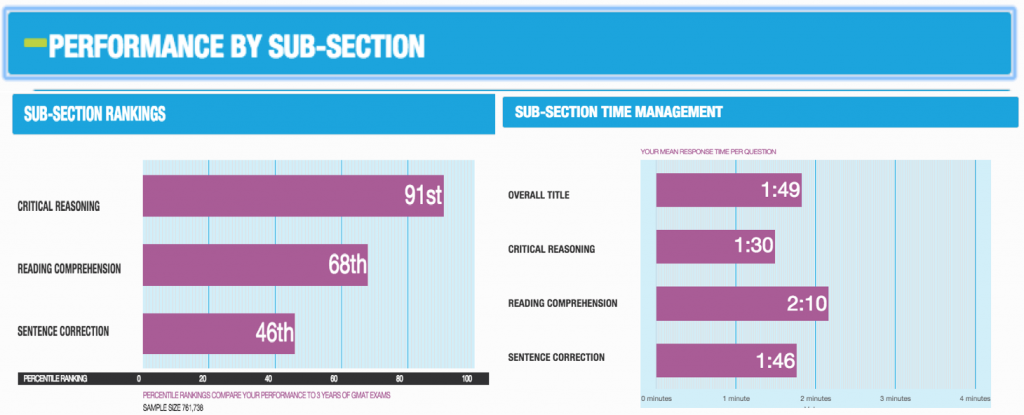
To check this, use another chart from your ESR named ‘sub-section time management.’ Compare the time spent with a ‘reference time’ as shown in the table below:
|
VERBAL Sub-Section |
Score (percentile) | Timing (actual) | Timing (Reference) |
| CR | 91 | 1:30 | 1:50 |
| RC | 68 | 2:10 | 1:50 |
| SC | 46 | 1:46 | 1:20 |
Look at the Performance Progression section and note down the time spent on each question for blocks 1 and 2.
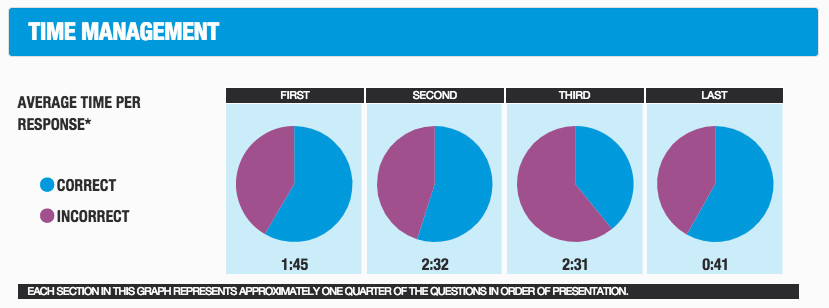
Compare these numbers with the reference table shown below:
| ESR Block | Time Spent | Reference Time |
| Block 1 | 1:45 | 1:20 |
| Block 2 | 2:32 | 2:00 |
There are 2 cases now-
- If time spent is more than the reference time, then it is a true representation of your ability
- If time spent is less than the reference time, then it may or may not be a true representation of your ability
Why it may not be a true representation of your ability? Because you did not spend enough time on these questions to get them correct.
3.2. Observations
In this Enhanced Score Report, clearly, Sentence Correction (46 percentile) is her weakest sub-section. But is it a true representation of her ability? Looking at the tables, we can see that it is a true representation of her ability.
She spent 1:46 on an average on each SC question which is more than the reference time of 1:20. Moreover, she spent on an average, more time on questions in Block 1 and 2. It’s not that she rushed during these blocks. Therefore, we can conclude that her SC score is a true representation of her ability.
3.3. Takeaways
- She is strong in CR (91 percentile), average in RC (68 percentile) and weak in SC (46 percentile).
- She is comfortable solving CR questions. However, she is spending less than the reference time on CR questions, and she must not rush through them.
- Her score in RC and SC is a direct consequence of her lack of ability in these sections and has nothing to do with time constraints of the test.
- Therefore, she must build her ability in RC and SC, so that she doesn’t have to rush through the CR questions to save time to solve RC and SC questions.
4. Analyze your exam progression | GMAT ESR Analysis

We’ll analyze each block’s accuracy and difficulty level of questions. The goal is to understand to cause behind this score.
| GMAT ESR Block 1 | GMAT ESR Block 2 | GMAT ESR Block 3 | GMAT ESR Block 4 |
| Accuracy: 75%
Time/Que: 1:45 |
Accuracy: 71%
Time/Que: 2:32 |
Accuracy: 71%
Time/Que: 2:31 |
Accuracy: 38%
Time/Que: 0:41 |
| Her accuracy is high
Average difficulty level is medium and she answered easier questions correctly She answered difficult questions incorrectly Her ability level is medium She spent more than the average time of 1:53 on wrong questions in this block |
The test increases the average difficulty level of questions in this block
Her accuracy level decreases slightly She answered difficult questions incorrectly in this block but the questions she got right have a higher difficulty level than the last block Her ability level is higher than block 1 She spent 2:11 on incorrect answers as compared to an average time of 2:32 on all answers* She used 45% more time per question in this block as compared to block 1, owing to the higher difficulty level of questions |
The difficulty level is slightly decreased
Her accuracy is again 71% here Her ability level decreases slightly Her average time to answer remained the same as block 2 However, she wasted a lot of time (3:22) here on incorrect answers* That is why she’ll have very less time left for the last block |
The test decreased the difficulty level slightly
She is left with very less time in this block Moreover, she answered the easier question incorrectly here She rushed through the questions in this block spending a mere 0:41 on each question
|
*To find out the average time per question on correct and incorrect answers, just hover the mouse over the ‘average time per response’ pie charts in the ESR. To learn more visit this page on ESR demo.
4.1. Observations
- She started with high accuracy by answering medium difficulty questions in Block 1
- Judging by this the test increased the difficulty level of questions
- She managed to maintain her accuracy level in block 2 and 3 but spent a lot of time answering questions here
- Her ability level was not as high as the difficulty level of questions and therefore she ended up using more time in block 2 and 3
- She wasted approximately 13-15 minutes in block 2 and 3 on incorrect answers.
- Therefore, she did not have much time left for questions in block 4.
- She rushed in block 4 and ended up getting easy questions wrong and therefore the test judged her ability to be lower.
- She eventually got a V34
4.2. The cause of her low score – ability or time?
It’s her low ability level in Verbal which hampered her score, not the time. Why? Because she wasted time on questions above her ability level and even used more time on questions which she got right. Had her ability level been higher, she would have solved the questions in lesser time.
5. The path to improvement | GMAT ESR Analysis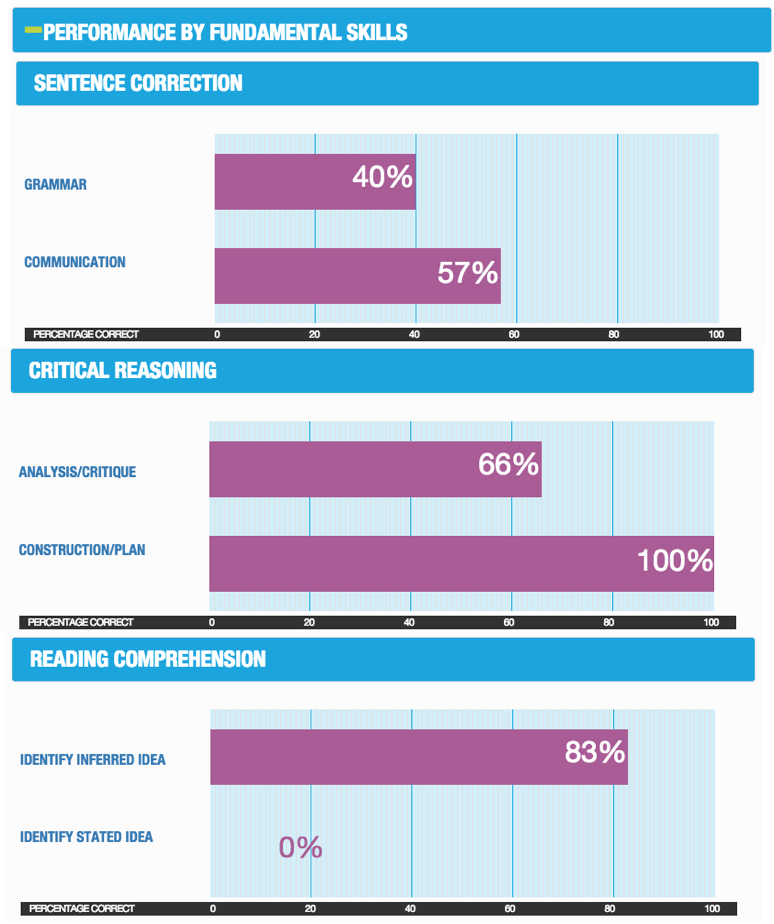
There are 2 aspects to creating a path to improvement-
- Identifying weak topics to improve
- Which resource will help you improve?
To identify your weak topics, refer to ‘performance by fundamental skills’ section of your ESR. This is the new section in the updated GMAT ESR.
Let’s start with her weakest section, i.e. Sentence Correction.
Want to score a 99% tile score in the GMAT (760+)? A winning GMAT strategy ensures you hit your target GMAT Score. Attend our GMAT strategy session webinar and get started with developing your GMAT Strategy for a high GMAT score.
5.1. Sentence Correction
- Observations
- She got 40% questions on grammar and 57% questions on communication correct. She is weak in both types of questions and needs to improve her ability in both.
- Path to Improvement
- She should start by setting a target percentile by using the GMAT Planner.
- She should start with the concept files of e-GMAT’s SC Course and then move on to Application files.
- She should use the ‘skill data’ in Scholaranium to decide the path forward
Scholaranium is our advanced quizzing platform (Rated Higher than GMAT Prep mocks) which provides advanced data analytics. It can help you do the following:
Identify your weak areas within each section (say Modifiers, Parallelism in SC)
Improve upon them by revision of concepts and application
Track the improvement by taking custom quizzes from these identified areas.
5.2. Reading Comprehension
- Observations
- Her accuracy was high (83%) in ‘Identify Inferred Idea’ questions, but she performed very poorly in ‘Identify stated idea’ questions. She did not answer any question correctly.
- Path to Improvement
- She should use the ‘skill data’ in Verbal Scholaranium. It will help her identify the specific questions she should target to improve her RC score. In her case, those questions are ‘identify stated idea’ type.
5.3. Critical Reasoning
- Observations
- She is strong in Critical Reasoning. She has an impeccable accuracy of 100% in ‘Construction/Plan’ questions. However, she needs to improve her accuracy (66%) in ‘Analysis/Critique’ questions.
- Path to Improvement
- She should see her skill data in Scholaranium to improve this specific type of question. She should revise incorrect answers which will help her mitigate minor gaps in understanding.
6. Takeaways – Analyzing GMAT ESR
- There are 3 aspects to analyzing an ESR
- Identifying the structure of ESR
- Understanding your ability and progression
- Path to improvement
- You should judge your sub-sectional percentiles as a true representation of your ability by comparing your timings with the reference timing. If you took more time to solve questions than the reference time then it is a true representation of your ability
- You should check your test progression data to analyze the role of time and ability level on your score. If your score is less than V36, then it is highly probable that your score is dependent on your ability and time has no or little role in deciding your score
- The path to improvement depends on identifying your weaknesses, setting a goal, and improving your weak areas. Use GMAT Planner for goal setting and e-GMAT’s Scholaranium to focus on weak areas.
If you need help with ESR analysis, please write to us at acethegmat@e-gmat.com and we’ll help you out.
ESR images courtesy – mba.com
GMAT ESR FAQs
The full form of ESR is Enhanced Score Report.
ESR or Enhanced Score Report presents you with post-exam diagnostic information. In simple words, it tells you how you performed while taking the GMAT and provides data-driven insights on how you can plan your preparation to reach your target GMAT score. See this article for more details.
An ESR costs $30. Check out this article on who should buy an ESR.


